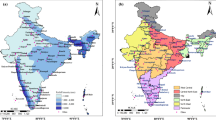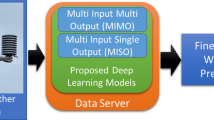Abstract
Hydrological impacts of global climate change on regional scale are generally assessed by downscaling large-scale climatic variables, simulated by General Circulation Models (GCMs), to regional, small-scale hydrometeorological variables like precipitation, temperature, etc. In this study, we propose a new statistical downscaling model based on Recurrent Neural Network with Long Short-Term Memory which captures the spatio-temporal dependencies in local rainfall. The previous studies have used several other methods such as linear regression, quantile regression, kernel regression, beta regression, and artificial neural networks. Deep neural networks and recurrent neural networks have been shown to be highly promising in modeling complex and highly non-linear relationships between input and output variables in different domains and hence we investigated their performance in the task of statistical downscaling. We have tested this model on two datasets—one on precipitation in Mahanadi basin in India and the second on precipitation in Campbell River basin in Canada. Our autoencoder coupled long short-term memory recurrent neural network model performs the best compared to other existing methods on both the datasets with respect to temporal cross-correlation, mean squared error, and capturing the extremes.


















Similar content being viewed by others
References
Bahdanau D, Cho K, Bengio Y (2014) Neural machine translation by jointly learning to align and translate. ICLR 2015
Bardossy A, Plate E J (1992) Space-time model for daily rainfall using atmospheric circulation patterns. Water Resour Res 28(5):1247–1259
Bardossy A, Duckstein L, Bogardi I (1995) Fuzzy rule-based classification of atmospheric circulation patterns. Int J Climatol 15:1087–1097
Bastien F, Lamblin P, Pascanu R, Bergstra J, Goodfellow I, Bergeron A, Bouchard N, Warde-Farley D, Bengio Y (2012) Theano: new features and speed improvements. Deep Learning and Unsupervised Feature Learning, NIPS 2012 Workshop
Bengio Y, Goodfellow I, Courville A (2015) Deep learning. Book in Preparation for MIT Press
Bergstra J, Breuleux O, Bastien F, Lamblin P, Pascanu R, Desjardins G, Turian J, Warde-Farley D, Bengio Y (2010) Theano: a CPU and GPU math expression compiler. Scipy, vol. 4, p. 3. Austin
Bi E G, Gachon P, Vrac M, Monette F (2015) Which downscaled rainfall data for climate change impact studies in urban areas? Review of current approaches and trends. Theoretical and Applied Climatol. Springer
Breiman L, Friedman J H, Olshen R A, Stone C J (1984) Classification and regression trees. Brooks/Cole Publishing, Monterey
Burger G, Murdock TQ, Werner AT, Sobie SR, Cannon AJ (2011) Downscaling extremes - an intercomparison of multiple statistical methods for present climate. J Clim 25:4366–4388
Christensen J H et al (2007) Climate change 2007: the physical science basis-contribution of working group I to the fourth assessment report of the intergovernmental panel on climate change. Cambridge Univ. Press, Cambridge
Conway D, Jones P D (1998) The use of weather types and air flow indices for GCM downscaling. J Hydrol 212/213:348–361
Corte-Real J, Zhang X, Wang X (1995) Downscaling GCM information to regional scales: A non-parametric multivariate regression approach. Clim Dyn 11:413–424
Dahl G, Yu D, Deng L, Acero A (2012) Context-dependent pre-trained deep neural networks for large-vocabulary speech recognition. IEEE Trans Audio Speech Lang Process 20(1):30–42
Dibike Y B, Gacon P, Hilaire A S, Ouarda T, Nguyen V (2007) Uncertainty analysis of statistically downscaled temperature and precipitation regimes in Northern Canada. Theoretical and Applied Climatology. Springer
Dobson A J (2001) An introduction to generalized linear models, 2nd edn. Chapman and Hall, London
Efron B, Tibshirani RJ (1993) An introduction to the bootstrap. Chapman & Hall/CRC
Gope S, Sarkar S, Mitra P, Ghosh S (2016) Early prediction of extreme rainfall events: a deep learning approach. ICDM 2016:154–167
Hanssen-Bauer I, Achberger C, Benestad R, Chen D, Forland E (2005) Statistical downscaling of climate scenarios over Scandinavia. Clim Res 29(3):255–268
Hastie T J, Tibshirani R J (1990) Generalized additive models. Chapman and Hall, London
Hay L E, McCabe G J, Wolock D M, Ayers M A (1991) Simulation of precipitation by weather type analysis. Water Resour Res 27(4):493–501
Haylock M R, Cawley G C, Harpham C, Wilby R L, Goodess C M (2006) Downscaling heavy precipitation over the UK: a comparison of dynamical and statistical methods and their future scenarios. Int J Climatol 26:1397–1415
Hinton GE, Salakhutdinov RR (2006) Reducing the dimensionality of data with neural networks. SCIENCE, vol. 13, 2006
Hinton G, Deng L, Yu D, Dahl G E, Mohamed A, Jaitly N, Senior A, Vanhoucke V, Nguyen P, Sainath TN et al (2012) Deep neural networks for acoustic modeling in speech recognition: the shared views of four research groups. Signal Process Mag IEEE 29(6):82–97
Hochreiter S, Schmidhuber J (1997) Long short-term memory. Neural Comp 9(8):1735–1780
Hughes J P, Guttorp P (1994) A class of stochastic models for relating synoptic atmospheric patterns to regional hydrologic phenomena. Water Resour Res 30(5):1535–1546
Hughes J P, Lettenmair D P, Guttorp P (1993) A stochastic approach for assessing the effect of changes in synoptic circulation patterns on gauge precipitation. Water Resour Res 29(10):3303–3315
Hughes J P, Guttorp P, Charles S P (1999) A non-homogeneous hidden Markov Model for precipitation occurence. J R Stat Soc Ser C Appl Stat 48(1):15–30
Hutchinson M F, Xu T (2013) Anusplin Version 4. 4 User Guide, 52p
Intergovernmental Panel on Climate Change - Task Group on Scenarios for Climate Impact Assessment (1999) Guidelines on the use of scenario data for climate impact and adaptation assessment. Version 1, 69 pp
Johnson F, Sharma A (2009) Measurements of GCM skill in predicting variables relevant for hydroclimatological variables. J Clim 22:4373–4382. https://doi.org/https://doi.org/10.1175/2009JCLI2681.1.
Kalnay E et al. (1996) The NCEP/NCAR 40-years reanalysis project. Bull Am Meteorol Soc 77(3):437–471
Kannan S, Ghosh S (2011) Prediction of daily rainfall state in a river basin using statistical downscaling from GCM output. Stochastic Environ Res Risk Assess 25:457–474. https://doi.org/10.1007/s00477-010-0415-y
Kannan S, Ghosh S (2013) A nonparametric kernel regression model for downscaling multisite daily precipitation in the Mahanadi basin. Water Resour. Res. Res. 49:1360–1385
Karl T R, Wang W C, Schlesinger M E, Knight R W, Portman D (1990) A method of relating general circulation model simulated climate to observed local climate. Part I: seasonal statistics. J Clim 3:1053–1079
Kingma D, Ba J (2015) Adam: a method for stochastic optimization. ICLR
Liu JN, Hu Y, You JJ, Chan PW (2014) Deep neural network based feature representation for weather forecasting. In: Proceedings on the international conference on artificial intelligence (ICAI). The steering committee of the world congress in computer science, computer engineering and applied computing (WorldComp), 2014, p 1
Mandal S, Srivastav R K, Simonovic S P (2016) Use of beta regression for statistical downscaling of precipitation in the Campbell River basin, British Columbia. J Hydrol 538:49–62
McQueen J (1967) Some methods for classification and analysis of multivariate observations. In: Proceedings of the Fifth Berkeley symposium on mathematical statistics and probability, vol 1. Univ. of Calif. Press, Berkeley, pp 282–297
Mikolov T, Karafiat M, Burget L, Khudanpur S (2010) Recurrent neural network based language model. INTERSPEECH 2010
Murphy J M (1999) An evaluation of statistical and dynamical techniques for downscaling local climate. J Clim 12(8):2256– 2284
Perkins SE, Pitman AJ, Holbrook NJ, McAneney J (2007) Evaluation of the AR4 climate models’ simulated daily maximum temperature, minimum temperature, and precipitation over Australia using probability density functions. J Clim 20(17):4356–4376
Prudhomme C, Reynard N, Crooks S (2002) Downscaling of global climate models for flood frequency analysis: where are we now? Hydrol Processes 16:1137–1150
Raje D, Mujumdar P P (2009) A conditional random field-based downscaling method for assessment of climate change impact on multisite daily precipitation in the Mahanadi basin. Water Resour Res 45:W10404. https://doi.org/10.1029/2008WR007487
Rajeevan M, Bhate J, Kale J D, Lal B (2006) High resolution daily gridded rainfall data for the Indian region: analysis of break and active monsoon spells. Curr Sci 91(3):296–306
Richardson C W (1981) Stochastic precipitation of daily precipitation, temperature, and solar radiation. Water Resour Res 17(1):182–190
Richardson C W, Wright D A (1984) A model for generating daily weather variables, USDA Agric. Res. Serv. Rep. ARS-8, US Dep. Agric. Res. Serv. Temple, Tex
Sharma A (2000) Seasonal to interannual rainfall probabilistic forecasts for improved water supply management. Part 1: a strategy for system predictor identification. J Hydrol 239:249–258
Shephard D (1968) A two-dimensional interpolation function for irregularly-spaced data. In: Proceedings of the 1968 23rd ACM national conference, (ACM’68), vol 517. ACM, New York, p 524, DOI https://doi.org/10.1145/800186.810616
Sutskever I, Vinyals O, Le Q V (2014) Sequence to sequence learning with neural networks. Adv Neural Inf Process Syst 3104–3112
Vandal T, Kodra E, Ganguly S, Michaelis A, Nemani R, Ganguly A R (2017) DeepSD: generating high resolution climate change projecions through single image super-resolution. KDD
von Storch H (1995) Inconsistencies at the interface of climate impact studies and global climate research. Meteorol Z 4 NF:72–80
von Storch H (1999) The global and regional climate system. In: von Storch H, Floscr G (eds) Anthropogenic climate change. Springer, Berlin, pp 3–36
von Storch H, Zorita E, Cubash U (1993) Downscaling of global climate change estimates to regional scales: an application to Iberian rainfall in wintertime. J Clim 6:1161–1171
Wetterhall F, Halldin S, Xu C (2005) Statistical precipitation downscaling in central Sweden with the analogue method. J Hydrol 306:174–190
Wilcoxon F (1945) Individual comparisons by ranking methods. Biometrics 1:80–83
Wilby R, Hassan H, Hanaki K (1998) Statistical downscaling of hydrometeorological variables using general circulation model output. J Hydrol 205(1–2):1–19
Wilby R L, Wigley T M L (1997) Downscaling general circulation model output: a review of methods and limitations. Prog Phys Geogr 21:530–548
Wilby R L, Hey L E, Leavesly G H (1999) A comparison of downscaled and raw GCM output: implications for climate change scenarios in the San Juan River Basin, Colorado. J Hydrol 225:67–91
Wilks D S (1998) Multisite generalization of a daily stochastic precipitation generation model. J Hydrol 210:178–191
Wilks D S (1999) Multisite downscaling of daily precipitation with a stochastic weather generator. Clim Res 11:125–136
Wilks D S (2006) Statistical methods in the atmospheric sciences, 2nd edn. Academic, Amsterdam, p 627
Yee T W, Wild C J (1996) Vector generalized additive models. J R Stat Soc Ser B 58:481–493
Yang C, Chandler RE, Isham V S, Wheater H S (2005) Spatial-temporal rainfall simulation using generalized linear models. Water Resor Res 41:W11415. https://doi.org/10.1029/2004WR003739
Zaytar M A, El Amrani C E (2016) Sequence to sequence weather forecasting with long short term memory recurrent neural networks. Int J Comput Appl 143:11
Acknowledgements
We would like to thank Subimal Ghosh of IIT Bombay and Kannan Shanmugham of IBM India Pvt. Ltd., Bangalore, India for sharing the codes and data for their work on kernel regression based statistical downscaling and Slobodan Simonovic and Sohom Mandal of the University of Western Ontario for sharing the codes and data for their work on beta regression based statistical downscaling. We would also like to thank Ministry of Human Resource Development, India and Indian Institute of Technology, Kharagpur for funding our work as a part of the project “Artificial Intelligence for Societal needs” and the Indian Meteorological Department for providing us the Indian rainfall data.
Author information
Authors and Affiliations
Corresponding author
Additional information
This work was supported by MHRD, Govt. of India and Indian Institute of Technology, Kharagpur.
Rights and permissions
About this article
Cite this article
Misra, S., Sarkar, S. & Mitra, P. Statistical downscaling of precipitation using long short-term memory recurrent neural networks. Theor Appl Climatol 134, 1179–1196 (2018). https://doi.org/10.1007/s00704-017-2307-2
Received:
Accepted:
Published:
Issue Date:
DOI: https://doi.org/10.1007/s00704-017-2307-2




